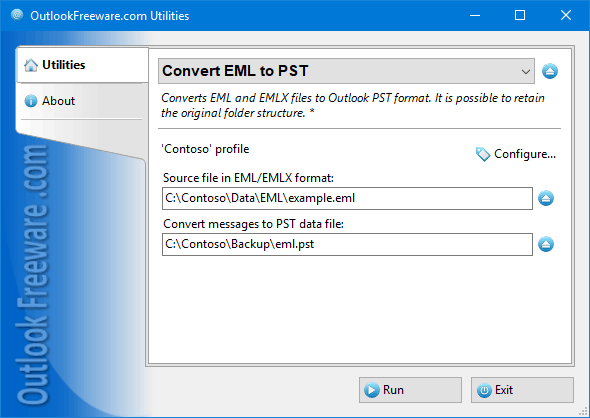|
Free EML and EMLX to PST converter for Microsoft Outlook.
| Publisher: |
Relief Software |
 |
| Downloads: |
1 |
| Software Type: |
Freeware, 0.00 |
| File Size: |
313K |
| OS: |
Windows All |
| Update Date: |
22 January, 2019 |
This free utility converts email message files from EML to PST format for Outlook. From a large number of EML files in different folders, one or more PST files are being created, depending on the settings of the utility. For example, when converting EML messages, the utility can immediately split the resulting PST files by size or by year.
Messages in EML and EMLX formats are used by different email clients: Windows Live Mail, Mozilla Thunderbird, Apple Mail and others, but Outlook does not work directly with them. You must import these files into Outlook or convert them to an Outlook-friendly format. Outlook uses PST data files to store your email. After the messages are converted from EML to PST, the resulting data file can be opened in Outlook.
The messages in the resulting PST files will be the same as if you received them directly in Outlook. All images, HTML formatting, attachments, and headers will be retained in the original form. When converting, source EML files can be moved to another folder. Here, when you run the utility again on the same source folder, no duplicate messages will be created in PST files.
Sometimes, instead of importing EML into Outlook, it is necessary to convert EML to PST. For example, you must save messages from cloud or NAS to local PST files, creating a separate PST file for each year, month, or day. Another example is migrating old user mailboxes, without importing them and connecting them to Outlook.
Conversion of messages from EML to PST is used for migration or preparation for migrating an old email database from EML format to Outlook and Exchange Server mailboxes. Folders with EML files allow you to estimate the size of the new message database and migrate the data in parts. For converting EML to PST by schedule or in batch files, use the command line capabilities. By using the command line, you can create mail migration scripts for any number of users in organizations of all sizes.
|




